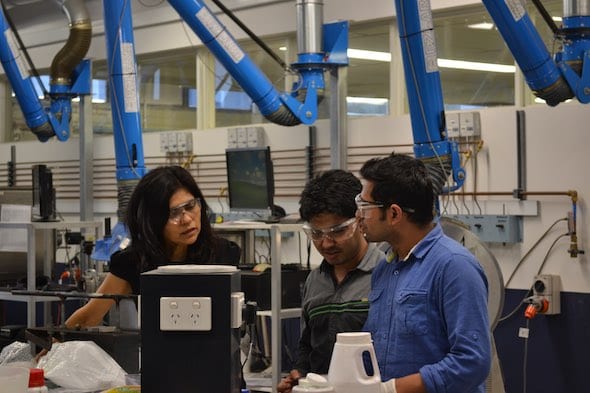 copy](https://reneweconomy.wpengine.com/wp-content/uploads/2017/10/DSC_033811-copy-590x393.jpg)
The team, led by University of New South Wales Scientia Professor Veena Sahajwalla, has been working together for nearly two years now on developing new processes to recycle complex waste, including old printer plastic shells and wrecked cars.
But rather than seeking to turn plastics into plastics, and glass into glass, Professor Sahajwalla and her team are working to develop new processes to transform this waste into something completely different: valuable commodities that can be used in industry.
Based out of the $8.8 million Australian Research Council Green Manufacturing Hub at UNSW, the team – in collaboration with the University of Wollongong, the University of Sydney, Victoria’s Monash University and a number of industry partners – has been developing technologies that can convert automotive waste into metal alloys, integrate agricultural waste into ferrous processing and use waste plastic to make green ceramics.
They are also working to deliver cost effective solutions for recycling e-waste, which – not surprisingly – has become the world’s fastest growing rubbish stream.
 copy](https://reneweconomy.wpengine.com/wp-content/uploads/2017/10/IMG_030211-copy-590x885.jpg)
“It offers a whole new life for material – bringing it all back to life, but not as what it was before.
“In many instances you cannot do like for like (recycling) … (This research) is opening up a whole realm of new possibilities that didn’t exist before. And if they are value added materials, that is a bonus.”
Sahajwalla cites the mix of plastics found in old cars as one great source of elements that are “so valuable,” like carbon. “How do you utilise that carbon and don’t lose it? Putting these things in landfill is such a waste of really useful elements.”
And from the glass of the car’s windows and wind-screen – or from computer screens – comes silica, which can be combined with the carbon to make silicon carbide.
So far, the team has used the silicon carbide it has created to produce nanowires for use in water purification.
And while using silicon carbide in this way is nothing new, Sahajwalla says “the new part is the fact that we’ve done it from waste feedstock.
“This is the first step towards delivering the goals we were talking about,” she said. “There are many, many applications for silicon carbide. To have something as high value as this, that can be used in a diversity of applications, is a great way to prove the point.
“You can actually generate, locally, a lot of these high performing materials, and put that into practice.”
It’s an exciting concept, and not just for its potential contributions to global sustainability. It has some promising economic and social side effects, too.
The team has also developed its own microfactory model: a custom designed small-scale solution that can be set up relatively easily, and to scale, to transform waste into valuable resources.
In April, the UNSW team used this microfactory technology to create a replica of Mahatma Gandhi’s glasses using waste plastics from thrown away electronic goods, recycled into plastic filaments for 3D printing – an “icon of hope”; for a sustainable future that is also a hat-tip to Mahatma Gandhi’s words, “Be the change you want to see in the world.”
It is for all of these reasons, the UNSW-based team collected the inaugural PLuS Alliance Prize for Research Innovation – a $25,000 award presented at the Times Higher Education World Academic Summit in London earlier this month, in recognition of outstanding innovation contributions that address some of the world’s biggest challenges.
For Sahajwalla, winning the price was “a really nice way to recognise the fact that it’s about sustainability, but also about social justice.
“The point we were trying to establish is that you don’t have to have these two goals as mutually exclusive,” she told RE.
“The exciting part of where we’re headed is to develop further and deliver microfactory technology, allowing people in all kinds of places to take the locally available waste and not see it is an environmental burden but as a enterprise and local job opportunity.
“People in the business of waste plastics, they would want to add more value to their waste. You don’t want to be doing the same old same old.”
The industry partners at the ARC green manufacturing hub include the Australian arm of international waste recovery company TES, and on the steel side, Moly-Cop, which is looking to use the UNSW technology to make innovative and strong steel products.
“To use waste as the input resource, means that we’ve addressed the critical problem of how do we make it cost-effective; truly beneficial to everyone on the planet,” Sahajwalla said.
“We are seeing different types of companies, seemingly from completely different sectors, work together in an ecosystem – a plastics company working with a steel manufacturer. It’s quite unique situation.”










